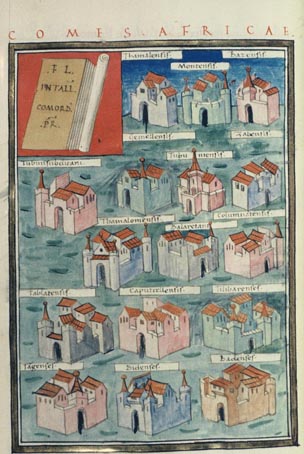
This page created 18 December, 2002, and last modified: 4 January 2015 (Equites scutarii iuniores scholae secundi name corrected)

 Above: Frontpiece from the Bodleian manuscript (O). The stations depicted are: Thamalensis, Montensis, Bazensis, Gemellensis, Tubuniensis, Zabensis, Tubusubditani, Thamallomensis, Baleretani, Columntensis, Tablatensis, Caputcellensis, Tillabarenses, Tangenses, Bidenses, Badenses.
|
The following commanders of Limitanei units or detachments of units are listed as being at the disposal of the Count of Africa (the numbers in front of the names refer to Ingo Maier's numbering scheme):
128.3 Praepositus limitis ThamallensisIn addition, the following infantry units are listed as being under the command of the Count of Africa, drawn from the Magister Peditum's Infantry roster: 102/5.193 Celtae iuniores (an auxilia palatina unit)along with the following cavalry units, drawn from the Magister Equitum's cavalry roster: 102/5.231 Equites stablesiani italiciani (a vexillationes comitatenses) |
Note that Seeck bracketed (OC.VII.195) the descriptor comitatenses in the Equites scutarii iuniores comitatenses in his edition as something to be deleted; why he did this is unknown... This unit would appear to be the same as the Sagittarii iuniores of the Magister Equitum's cavalry roster, given their position in their respective lists.
Another unit named Fortenses, also a legiones comitatenses, with a separate shield pattern, is listed in the Magister Peditum's infantry roster, but stationed in Spain , but its position in the Magister Peditum's list compared with this one makes the assignment of the two shield patterns to the two units certain. This African Fortenses legion would appear to be the same as the Milites Fortenses under the Dux Tripolitanae.
Seeck identified the Constantiaci with the Flaviae victrices constantinae id est Constantici, and the Constantiniani with the Secunda Flavia Constantiniana; Jones swapped Seeck's assignments around. I now believe Seeck was right (formerly I believed neither were...).
The positioning of the Cimbriani and the Armigeri propugnatores seniores and iuniores, after the Celtae iuniores, indicates that they were comitatenses units when the Notitia was first drawn up, but later promoted to the palatine status they are recorded having under the list of the Magister Peditum. Half of the 12 palatine legions in the western empire are such recently upgraded units.
Whether none, some, or all of the limitanei units are identical to any of the comitanses units listed under the Comes' command is hard to say, as there is no indication of the limitanei units' titles, just their geographical station.
The inordinate amount of cavalry present suggests to me that there has been a mistake here, and that some of these really belong, as I argue under the "Comes" Hispenias, to that officer (since he has none), perhaps all those from the Equites promoti iuniores and below (and therefore likely including the Comites iuniores in addition?), because the Equites citrati seniores is placed out of position just above this division.
"Another" unit of Equites scutarii seniores is found under the Comes Tingitaniae. Similarly, "another" Praepositus limitis Caputcellensis is listed under the Dux et praeses provinciae Mauritaniae et Caesariensis, and similarly for the Praepositus limitis Columnatensis; these may very well be the same units, but separated in time rather than space.
Below are shown the appropriate shield patterns taken from the Parisian manuscript, P:

It is noteworthy that only a single unit of auxilia palatina is included - noteworthy not just because this is a small number for such a large command, but also because it is a small odd number; such units seem to have normally been brigaded in pairs.

Return to the Notitia index page.